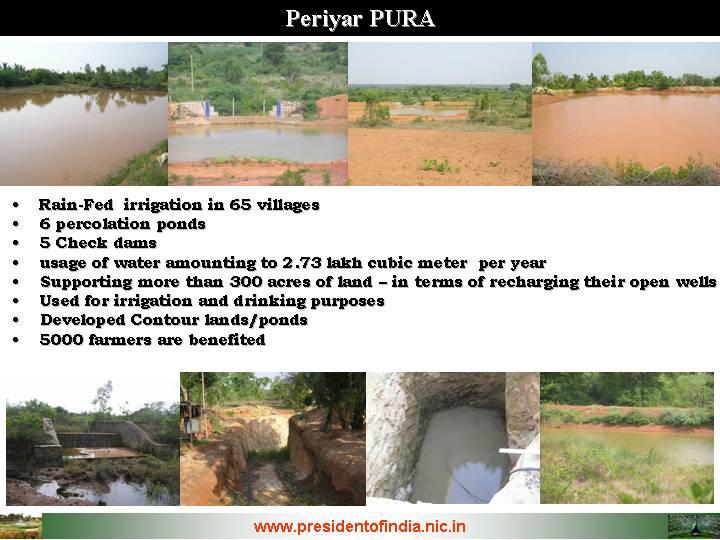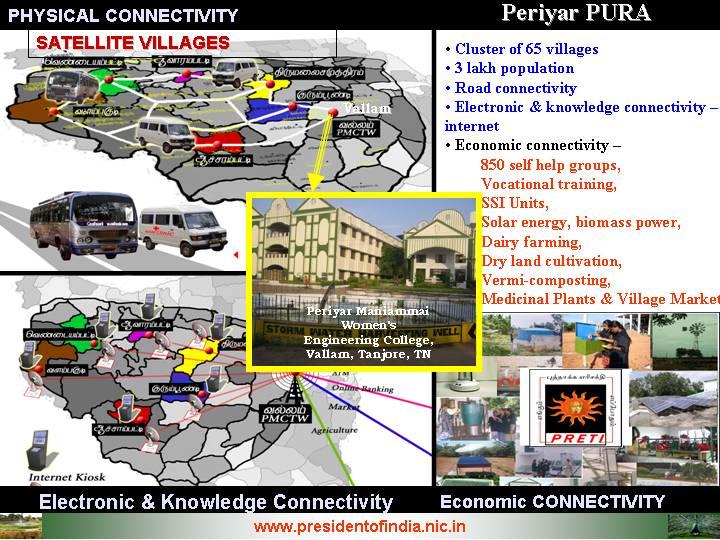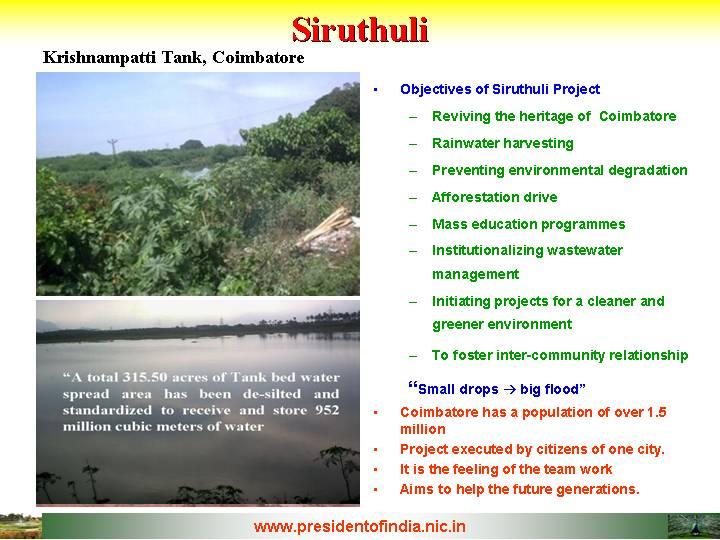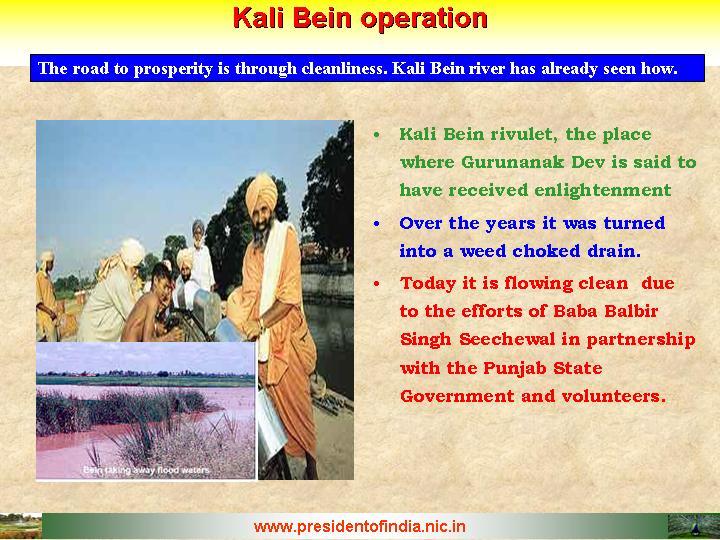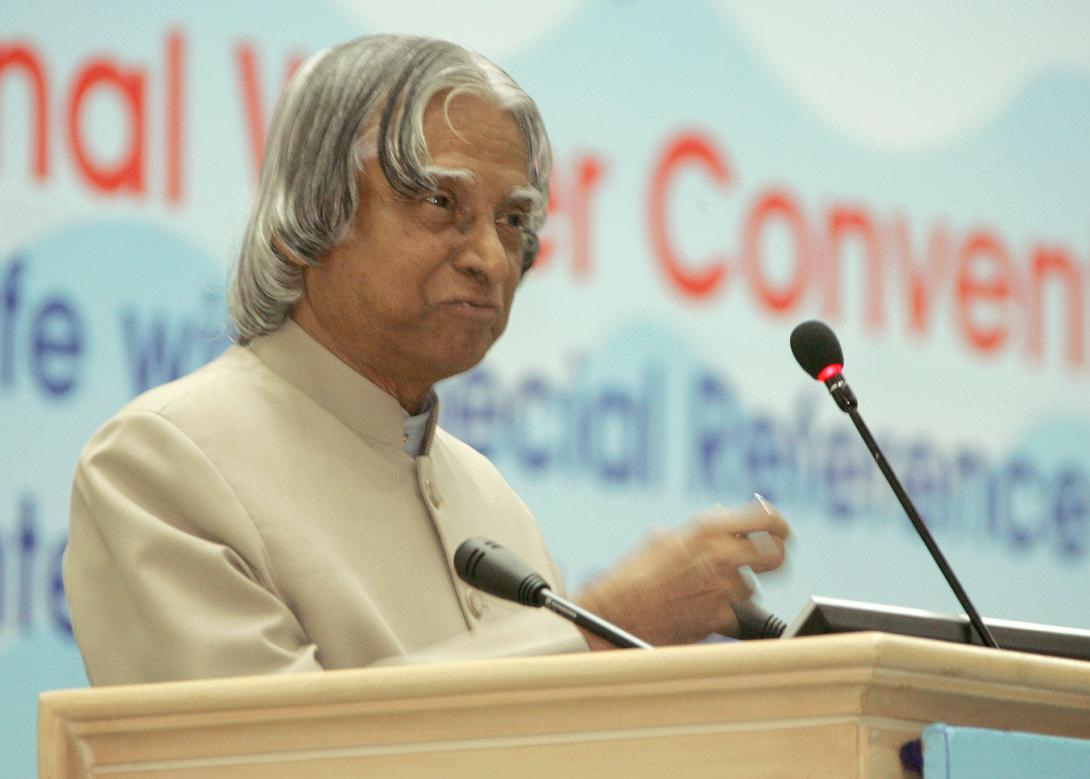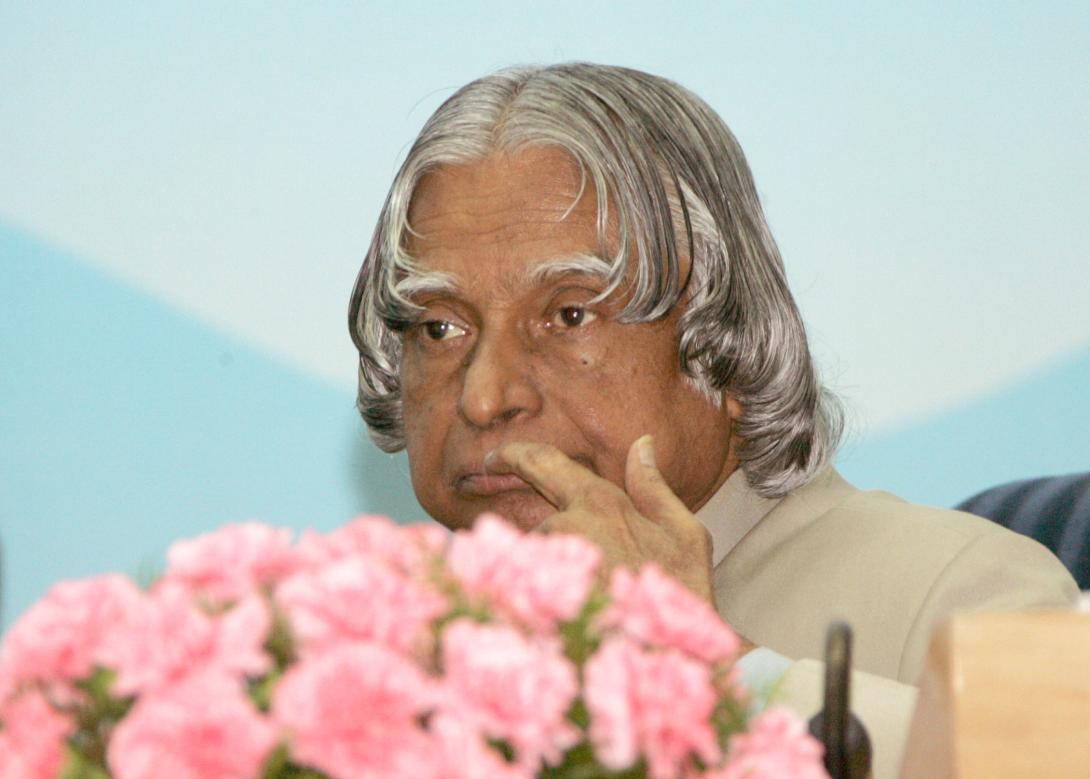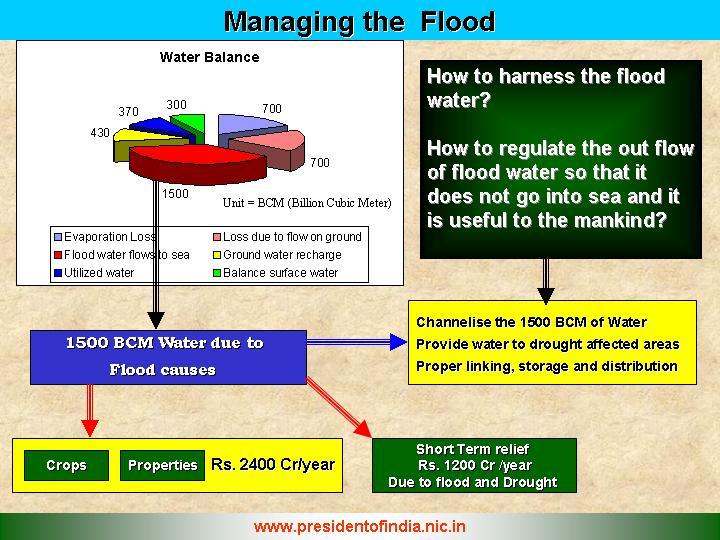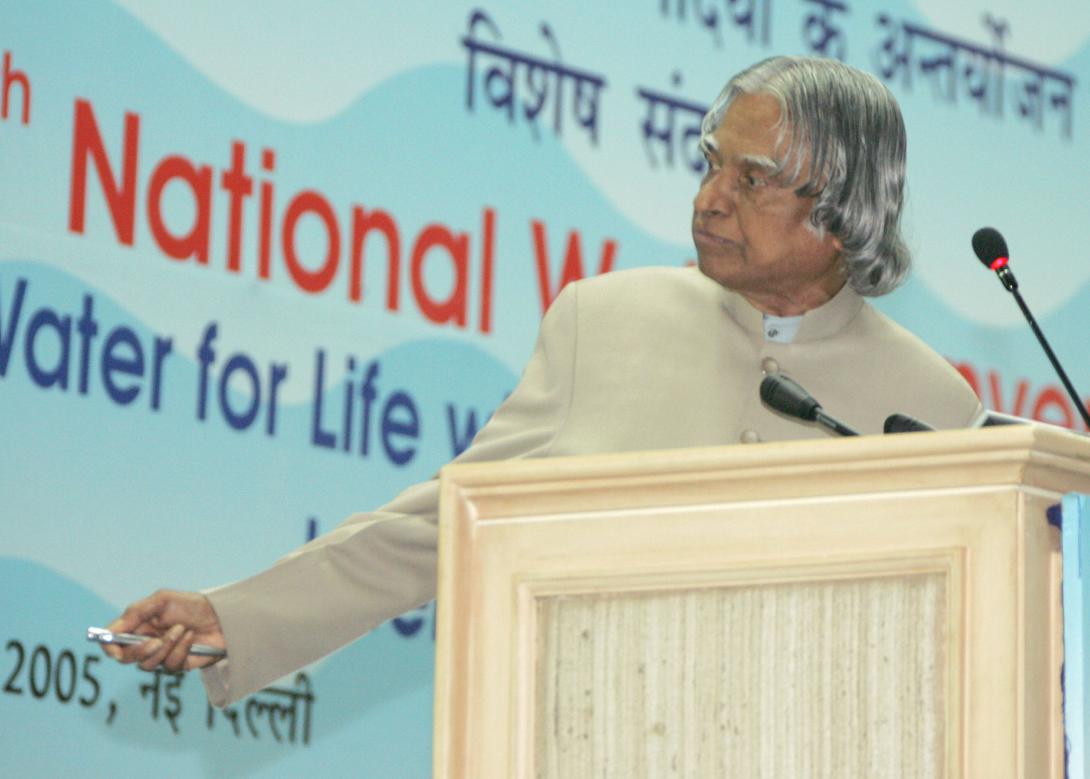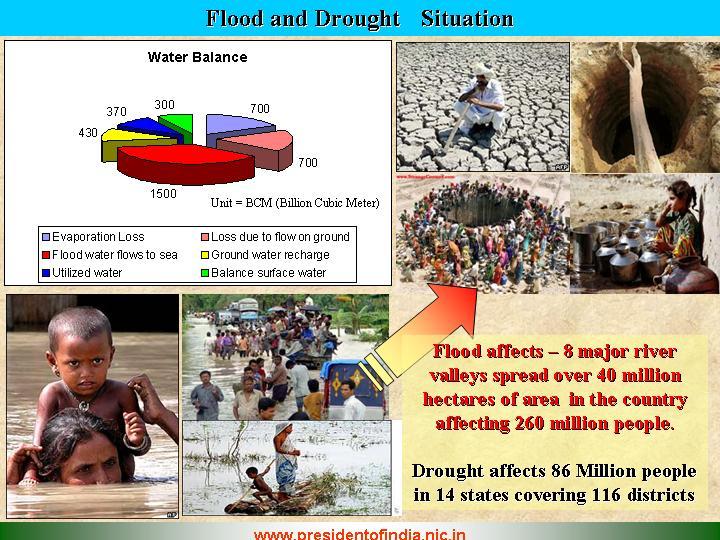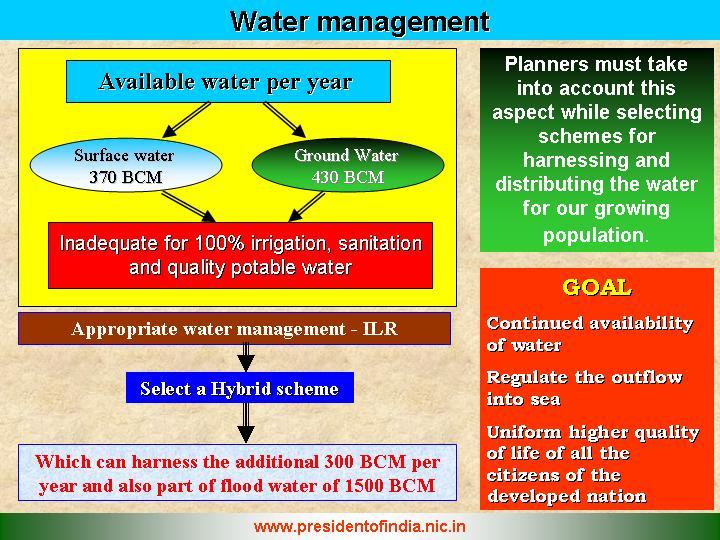Inaugural Address at the National Water Convention 2005
NEW DELHI : 11-05-2005
Integrated water mission
I am delighted to participate in the inauguration of the National Water Convention 2005. The topic selected for the convention is ?Water for Life with special reference to Interlinking of Rivers in India? organized by the Ministry of Water Resources. I greet the organizers, participants and enlightened dignitaries for addressing this major issue in this annual convention. I was thinking what I can share with the delegates of the conference who have come to discuss the very important issue of water management particularly conservation, development and management of water resources, and also our concern for providing water for irrigation and good quality potable water for all citizens of the country. There are also other concerns such as ecology, questions of displacement of human habitats etc. Therefore, my address will be on "Integrated Water Mission".
There are some who have great expectations about linking of rivers. There are also some others who have a question whether this programme will be a blessing for the country?
I would like to discuss four aspects with you.
1. What is the total requirement of water for our nation for drinking purposes, sanitation, irrigation and other industrial uses and what the nation gets through seasonal inputs (rain and melting of snow)?
2. One third of our population is affected by flood or drought every year.
3. Per capita availability of water varies from 10 kilo litre to 50 kilo litre for different seasons and regions.
4. What are the optimal ways of meeting the minimum needs of water for the entire population, assuming a particular population growth rate for the country. We should remember that by 2020 we have to produce approx. 400 million tons of grain and the water requirement will also go up due to population increase.
Water Balance
IIndia gets approximately 4000 Billion cubic meters (BCM) of water every year from all natural sources. Out of this 700 BCM are lost in evaporation and another 700 are lost during the flow on ground. Also, the large part of water namely 1500 BCM flows into the sea due to floods. Thus, the remaining available water is only 1100 BCM. Out of this ground water recharge accounts for 430 BCM per year and the present utilized surface water is 370 BCM. The balance unutilized water which can be harnessed is 300 BCM.
Flood and Drought Situation
I was studying the frequent occurrence of flood and drought. Flood normally affects, 8 major river valleys spread over 40 million hectares of area in the entire country affecting nearly 260 million people. Similarly the drought affects 86 million people who are spread in 14 States covering a total of 116 districts. Wherefrom this flood comes? It comes from the 1500 BCM of water every year flowing during the monsoon season. If we have to prevent the damage due to the flood and reduce the severity of drought, we have to harness this 1500 BCM of water and distribute it to the drought affected areas. We can also partly store it in proper storage system so that it can be available during non-monsoon months. If we succeed in doing all these, we will not only save the loss arising out of the damage caused to the crops, properties and people by the flood to the extent of Rs. 2400 crores on an average per year, we will also save the recurring expenditure of Rs. 1200 crores incurred by the government as short term relief measure. The questions which arise are how to harness the flood water? And how to regulate the out flow of flood water so that it does not go into sea and it is converted as useful water for the mankind.
Harnessing the Water
Hence our aim should be to channelise the 1500 BCM of flood water, so that it can be made use of for providing water to drought affected areas and make sufficient water available to the whole country during non-monsoon months through proper linking, storage and distribution. Our plans must consider that presently the sanitation facilities are not available in more than 50% of the dwelling units in the country. Planners must take into account this aspect while selecting schemes for harnessing and distributing the water for our growing population. We may have to align our interlinking of rivers project for meeting the growing water demands of the nation by having a hybrid scheme which can harness the additional 300 BCM per year and also the flood water of 1500 BCM.
Flood control:There is an urgent need to find long-term solution to control flood, store and utilize the surplus water during drought. In the Gangetic region, I would recommend construction of layered wells in the entry points of Kosi river in. Normally the flood water has certain dynamic flow conditions. The layered wells assist gradual reduction in dynamic flow velocity after filling each storage well. The water thus stored will be useful during shortage period. Similar solution can be found for the north-eastern region. I recommend this scheme can be included in the Interlinking of rivers programme.
Also the scheme chosen must be such that there is continuous availability of additional water for the growing population and the related needs of the nation by regulating the outflow into the sea.
Now I would like to discuss about the possible issues arising out of this mission. The main issues which concern certain number of people are rehabilitation and environmental upgradation.
Rehabilitation
While working on such large schemes, certain amount of displacement of people is bound to happen. We should aim at minimizing dislocations. We also have to consider the overall impact and benefits of the scheme which in this case is going to benefit nearly 340 million people who are affected constantly by floods or droughts. Rehabilitation Plan should include working out area required for providing housing for the affected families which have to be relocated, space required for the livelihood either agricultural, artisanal or industrial. Adequate funds required should become the component of the mission of ?Connecting Water Resources?. Also, by learning from the problems of the past, necessary new mechanisms have to be put in place to provide facilities to those who are likely to be displaced well in advance. Governance issues connected in these projects are equally important as technologies, project management, finances etc. The project report should consist of all these components before seeking sanction.
Environmental upgradation
There are certain apprehensions by environmentalists that the large-scale diversion of water and disturbance to the terrain may endanger or affect geological and ecological balance. It is therefore essential to find solution to their concern and build it as a part of the mission of interlinking of rivers. For example, the aforestation area could be increased 10 to 15 percent from the present forest area and also designing the river flow management. Therefore the comprehensive mission planned by the government will have to take in to account pooled allocations from the various departments and closely monitored, as it will have impact in every field of development programmes of many ministries of state and central governments.
Mapping the Water resources and the route planning
Science and Technology can surely help in executing such missions. India has its own remote sensing satellites and their applications will help in large-scale survey from the source and river flow pattern at various seasons. Optimum water routes and mapping of the environmental profile can be evolved using virtual reality through satellite and aerial imageries. Most important means is to use CARTOSAT-I for getting stereo type pictures on water resources and drought. This should become part of the Water Mission.
State wise linking local river basins
During my address to the Andhra Pradesh assembly, it was suggested that the Godavari water which flows into the sea to the extent of 2500 tmc during floods and 750 tmc during normal conditions may be diverted into the basin area for irrigation purposes through step dams, irrigation canals and water storage lakes and ponds. This will increase the irrigated area of the Godavari basin by over 30%. Andhra Pradesh government has agreed to implement this scheme. Also I was informed by the Chief Minister of Goa that the Government of Goa has interlinked Zuari river with Kalay river in Mandovi basin through installation of pumps and gravity flow. This has been done to ensure availability of drinking water in this region. Every State should be asked to inter-connect their own rivers on the lines of Goa. This should form part of the State Planning. Overall planning of interlinking of rivers has to integrate the state water resource connectivity.
Water Management
Simultaneously we have to undertake missions for water harvesting, recycling and environmental upgradation, for long term availability of 800 BCM surface and ground water. I would like to give some examples which have been implemented in different regions for study.
Water harvesting
Water harvesting and water recycling should become mandatory for all the states. To improve water table we need to build check dams; develop water sheds, desilt ponds and rivers, clear the inlets and outlets to the ponds and water bodies and recharge the wells. If our rural areas are made to have the operational clean water bodies, recharging of the wells will take place. These activities will also generate employment. Tamil Nadu government has taken the lead and made water harvesting as a mandatory requirement for all house holders in the states including rural areas . Studies indicate that this has resulted in considerable improvement in ground water level in this season. Recently the permanent housing scheme for tsunami affected people includes water harvesting in all houses. Some states have taken action to revive lakhs of water bodies of different types. They have also undertaken mini and micro water shed irrigation schemes to improve ground water level in drought prone areas to preserve the local rain water for irrigation.
Water Recycling
In addition to water harvesting, water recycling is an essential for large consumers such as hotels, public Institutions and industries. The recycled water must be used for all usages including agricultural needs, except for drinking. This will reduce the percapita requirement of water to nearly 25% of the present consumption and enable larger number of population to get adequate potable water and for sanitation.
Synergy Mission for Environmental Upgradation
The status of environmental cleanliness is one of the indicators of development of a nation. As a nation, we have to keep our environment clean and tidy including all our places of worship and rivers. I am delighted to learn the Kali Bein rivulet, the place where Gurunanak Devji is said to have received enlightenment. Over the years this rivulet has turned into weed choked drain. Recently river is clean due to the efforts of Baba Balbir Singh Seechewal in partnership with the Punjab State Government. From the discussions, I understand that he organized people?s participation in stopping the massive flow of sewage into the Bein and cleaned 160 km long polluted and choked rivulet within the last three and a half years by deploying on an average 3000 volunteer pilgrims per day. Today one can feel the flow of fresh water in this rivulet released from the Tarkina Barrage by the government about a year ago. The revival of the rivulet has recharged the water table as the hand pumps that had become dry for the past 4 decades are now pumping out water.
While I was thinking how we should solve the problem of improving the environment of rivers and religious places, I find one of our enlightened citizens has taken the initiative and demonstrated the power of ignited individuals to solve societal problem. Let this model spread in all the places of divine worship and inspire the pilgrims to participate in the task of clean environment in water and air. ?Thousands of local initiatives will make India green.?
Project Siruthuli - revitalizing a water body
This is an initiative started by Coimbatoreans for Coimbatoreans. This ecological project aims to bring back the glory of Coimbatore and its rich heritage. The project is represented by people from all walks of life and professionally organized. The primary focus is on large scale rain water harvesting, afforestation, sewage / waste water treatment and solid waste management. They have already standardized five of the nine primary tanks in Coimbatore for large scale rainwater harvesting. Over 600 saplings have been planted on the bunds of the de-silted tanks and are being maintained. They are moving towards a target of planting 15 lakh trees by the end of 2005. The comprehensive study has indicated outlet of the city sewage as 10 million liters per day. A pilot plant is being taken up for sewage treatment to treat one million liters per day. The treated water will be sold to the agriculturists and industrialists as a revenue earning measure. The garbage and debris to the extent of over 26,000 cubic meters in one of the city?s largest tank have been removed. This model can be replicated throughout the country.
Periyar PURA - Transformation of Rural Society
Recently I had visited Periyar Maniammai College of Technology for women and inaugurated a project called PURA (Providing Urban amenities in Rural Areas) Complex. Over 65 villages near Vallam, Thanjavur district of Tamilnadu, have been transformed as a PURA Cluster. It has a ring road and interconnecting roads covering major villages along with bus transport system.
They have innovative water management schemes for irrigation and providing potable water for all the village citizens. All 65 Periyar PURA villages are having only rain fed irrigation. Due to shortage of rainfall in that locality, farmers were suffering due to scarcity of water not only for agriculture but also for drinking purposes. Keeping this in mind, Periyar PURA developed six percolation ponds and five check dams to harness the rain water amounting to 2.73 lakh cubic meter per year. This water is supporting the irrigation of 300 acres of land through recharging their open wells and bore wells. It also supplies drinking water to the people. Periyar PURA has also developed alternate practices such as Contour lands, check dams across natural streams for water conservation and developed a model for irrigation for conservation of water. More than 5000 farmers are benefiting from this program. This example will be useful for water management in PURA complexes.
Conclusion
Our planet will encounter in the next few decades severe shortage of water if we are not careful in conserving and preserving precious water resources. In India, we should have action oriented plans to foresee the problem and work on a mission mode before the water situation worsens. It is essential that we must have a water management mission that unfurls our vision for next two decades, integrating interlinking of rivers, water harvesting, water re-cycling, and desalination of sea water using solar energy in specific areas.
I would suggest the following seven action points for this convention.
a. Recommending schemes which will ensure availability of minimum 25 kilo liters of water per year for each citizen in the country.
b. The schemes chosen should also ensure that availability of water required for producing four hundred million tonnes of foodgrains per year by 2020. Simultaneously, It is suggested that the agricultural scientists need to develop crop varieties, similar to ICRISAT seeds, which will need minimum water .
c. Scheme chosen should ensure that no state is affected by flood or drought.
d. Water harvesting must be made mandatory for all buildings. Necessary legal provisions may be made in this regard.
e. Recommend appropriate legal provisions for making recycling of water mandatory in all buildings particularly large hotels and industries where large amount of water is consumed.
f. Expenditure required for rehabilitation and environmental upgradation should become part of the mission of ?connecting water resources?. Also a people oriented governance system should be in place to take care of affected people.
g. There are many schemes for interlinking of rivers. Ministry of Water Resources has to consolidate all the best aspects and bring out cost effective project report. As a whole, interlinking of rivers has to be a mission mode project.
I wish the 11th National Water Convention success in your mission of providing water for life to every citizen of the country.
May God bless you.

